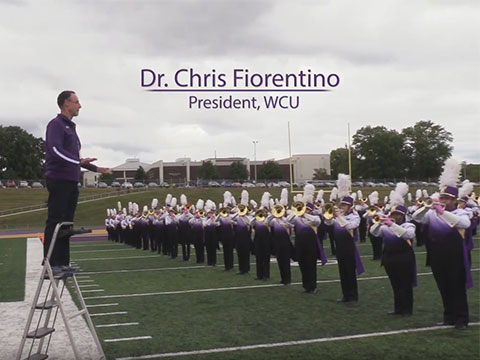#WCUPresidentialShadow: A Day in the Life of WCU's Marching Band Director
October 1, 2017
If Andrew Yozviak wasn't WCU's marching band director, he'd probably make a great air traffic controller. As I watched him in action at a recent rehearsal at Matlack Fields, I was reminded of an old movie about air traffic controllers called Pushing Tin. Much like an air traffic controller, Yozviak needs to stay cool under pressure and make split-second decisions in ever-changing conditions. But in Yozviak's case, it's not DC-9s and 737s, but brass, woodwinds and percussion that he's pushing to land their notes just right.
Band practice looks nothing like the polished, precise and incomparable performances that the Golden Rams Marching Band put on at home football games. They make it look easy in Farrell Stadium but behind the scenes you quickly realize the myriad challenges Yozviak faces to ensure that 324 musicians and color guard members stay in step and in time throughout a 10-minute show.
It was a hot and steamy Friday afternoon when I shadowed Yozviak. In one section of the field, an undergraduate section leader repeatedly led the clarinets through a few measures of Stevie Wonder's Superstition. In another area, an undergraduate student coordinator worked on body mechanics with the tuba section, whose instruments were lined up waiting on the sidelines. The tuba players marched eight steps from one yard line to the next, then turned around and did it again. And again.
"Okay, that's a lot better, next we're going to be working on your shoulders," shouted the coordinator.
In the only patch of shade in sight, the color guard tossed their flags skyward. Over by the Matlack parking structure, the drum line worked furiously on a long groove with a tricky multiple bass drum part. Up on the roof of the structure, Greg Martin, associate director of bands, called out commands through a bullhorn. Meanwhile, Yozviak strided calmly through this sea of activity, once in a while pulling aside a student leader to make a suggestion.
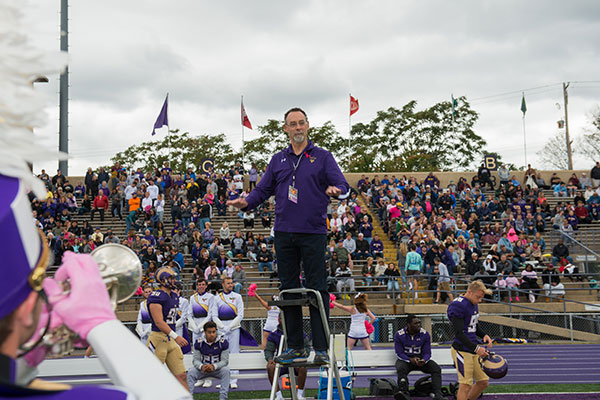
By late afternoon, it was time for the entire band to assemble on the field and work through the performance together. Yozviak clambered on to a platform, high atop steel scaffolding, and led the band in the WCU Fight Song as an easy warm up. Then it was my turn. I grew up in a family that valued and appreciated music, played two instruments as a kid, and still enjoy picking up the guitar when I get the chance. (Which, I must admit, hasn't happened in the last year.) But conducting a band? This wasn't in my wheelhouse. Nonetheless, I had to get it right at this one and only practice because I was scheduled to conduct the Fight Song at the next day's game.
The student musicians, as well as WCU marching band staff, showed the utmost patience as I worked through the song. Their kindness didn't surprise me but a few other things about leading a marching band did, such as how much the physics of sound matters.
You may recall learning back in high school that light travels fast, sound not so much so. In fact, the speed of light (670,616, 629 m.p.h.) is 881,000 times faster than the speed of sound (761 m.p.h.).
Seeing this concept actually play out before me was fascinating. The band practices on a large field - more or less the same size as the football field in Farrell Stadium. When the clarinets in the far right corner and the trombones in the far left corner play, it takes longer for their notes to travel to the middle of the field. If the musicians don't take into account this slight lag time, the Fight Song will sound like a cacophony of noise. The drum majors and staff help the musicians identify where on the field they need to listen so that their musical part is played in time. The end result - a harmonious tune, no matter where you're sitting in the stadium.
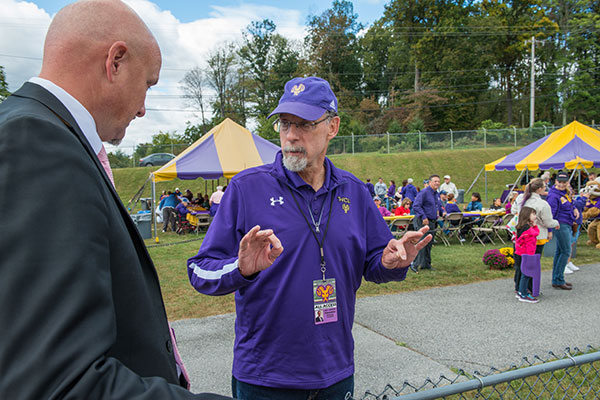
Yozviak and his staff created this year's halftime performance, dubbed The Feast, early this summer. This team included Martin; visual coordinator Todd Marcocci, and Darren Hazlett, percussion coordinator.
"That was really late for us, usually we have at least the vision for next year's presentation set before the current season is over," says Yozviak. "As for the method behind the magic, the four of us typically get together at Timothy's or another local restaurant and start brainstorming."
Brainstorming continues for weeks. Sometimes the best ideas come not at restaurants or in Swopes' practice rooms but while driving home from work, out for a weekend run, or in Yozviak's case, while feeding his 15-month-old son, Joseph, while his wife Liz practices her French horn in the early morning hours.
After the songs are set, the movements needs to be outlined in drill forms that tell each individual musician where he or she should be marching as each note is played. A few decades ago, this process was painstakingly done by hand. These days, computer drill programs make things a bit easier - for example, the software warns you if the drill you're trying to chart will make the flute section collide with the trumpet section. But, it's still a painstaking process. This year's 10-minute show is mapped out on 81 pages of drill forms.
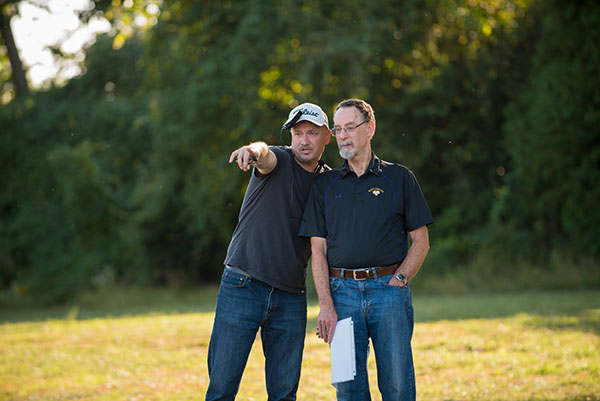
Incidentally, all four of these faculty members have other responsibilities in addition to marching band. Yozviak's official title is director of bands. He conducts the wind ensemble and chamber winds, and teaches graduate and undergraduate conducting classes.
"Marching band takes up only 25 percent of my time," says Yozviak with a wry smile. The reality is, while he meets his considerable responsibilities, such as getting the wind ensemble ready for an upcoming performance at Carnegie Hall, marching band could easily consume all of Yozviak's time during football season if he let it.
The Saturday I was set to conduct dawned overcast; rain was in the forecast but the precipitation held off. That was a good thing and not just because it's no fun to march in the rain. If a rain storm brought windy conditions, Yozviak and Marcocci would have quickly modified the color guard's routine, either by keeping the equipment tosses lower, or in extreme conditions, eliminating the tosses all together. Later, in the season, cold weather brings its own challenges. When it's colder, instruments produce a flatter sound, and in extreme temperatures, instrument valves can freeze shut.
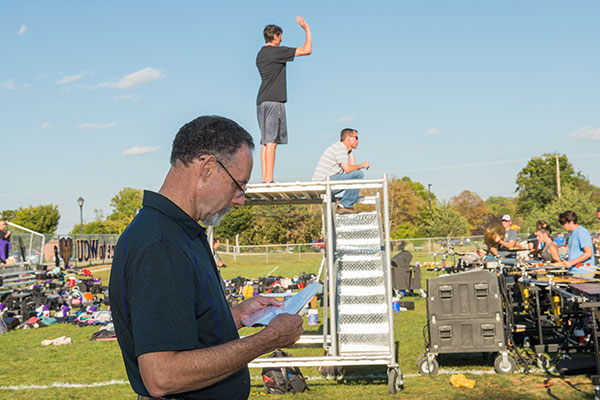
Fortunately, I only had to worry about my conducting ability, not the weather, when I arrived at the stadium that morning. My chief of staff, John Villella, was head or assistant conductor of the band for 24 years, so I sought out John on the sidelines for last-minute tips. Then I hopped up on a step ladder and led the Golden Rams in a rousing rendition of the Fight Song. As we concluded, the roar of the crowd was music to my ears.
I'd like to think the Fight Song sounded better that day than it ever has, but that may not be the case. What I do know to be true, now that I've (ever so briefly) worked as a band director, is that the sheer magic of our Incomparable Golden Rams is crafted from one percent inspiration and 99 percent perspiration.
Rams Up to Andy Yozviak and our Marching Band!

